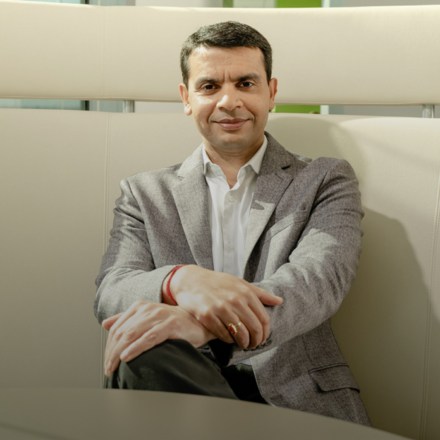Arvind Jain hunched over his desk, sifting through hundreds of employee surveys, searching for the answer to a problem. Rubrik, the cloud security company he had co-founded four years earlier in 2014, was one of the fastest-growing businesses in cloud data management. Since its launch, it had scaled from a handful of employees to almost a thousand. But a problem came to light in 2018: Productivity had stagnated. The company’s output wasn’t growing with its scale.
Jain pored over the results of the survey that had been commissioned, scouring for patterns. Was it talent? Not a chance. Company culture? Not according to the surveys. And then, a troubling insight: Employees reported spending hours of their time trying to find and piece together fragmented bits of information from across the 300 SaaS products Rubrik used in its internal operations—onboarding materials, meeting notes, support tickets, project archives and more. In their quest to find answers, they were stalled and sidetracked.
Rubrik’s problem, Jain realized, wasn’t Rubrik-specific, but universal: the seemingly impossible task of wrangling digital information from every facet of an enterprise. What if there was something like Google Search, but for the workplace? Jain began researching search engines for enterprises, but none could do what he imagined. “I spoke with other CEOs to see if they had solutions I’d missed,” Jain says. “Their response was, ‘If you find something like that, let us know.’”
“I spoke with other CEOs to see if they had solutions I’d missed. Their response was, ‘If you find something like that, let us know.’”
arvind jain
Search engines are notoriously difficult to build—they require crawlers sophisticated enough to index data in a multitude of formats in real time and algorithms smart enough to sort and rank that data with precision for any given search. What Jain was considering developing would be even more complicated, as every search would need to be personalized for every employee based on their degree of access to a company’s data.
Nonetheless, this provocation became the springboard for Jain’s next startup: an AI-powered search engine for enterprises called Glean. As it happened, Jain was the perfect person for the job.
In 2003, hundreds of employees unpacked boxes and settled into office space in Mountain View, California. Google had officially signed its new lease in the heart of Silicon Valley, taking over the former Silicon Graphics campus. While the new digs were reflective of Google’s success, the company was also at a crossroads.
Since its launch in 1998, Google had gained a loyal following of users. But as the internet evolved—growing rapidly in size and shifting from rudimentary websites to include pages that were more complicated and nonstandard—Google Search wasn’t able to keep up with the velocity of new data. Meanwhile, alternative search providers were closing in, the most competitive of which was Yahoo. “Google and Yahoo were locked in a battle for the most sophisticated, comprehensive web indices,” says Bill Coughran, a Sequoia partner who was then SVP of engineering at Google.
Coughran gathered the web crawler team and told them they needed a new system design. It would have to be able to respond to diverse and rapidly changing data, and do it at scale. The timeline for the new system? As soon as possible.
Arvind Jain, a recent hire then in his late 20s, was one of the leaders of what became the new effort. Over the next few weeks, Jain and his colleagues spent days analyzing Google’s search engine. Eventually, they approached Coughran with an idea for the new design.
“What was interesting about their vision is that it took advantage of the basic primitives Google’s web crawler already had in place and built on top of those,” Coughran says. “The design showed a system that could index not just websites, but dozens of file types from HTML to PDF, including PowerPoint, Flash, PostScript and JavaScript. And, as the web continued to scale, it could operate more and more instances of itself and do more and more work.”
“My experience with Arvind, certainly at the time and since, is that he’s meticulous and thoughtful about how he does things.”
Bill Coughran
Some senior executives, however, viewed the proposed framework with skepticism. “They looked at the design and just didn’t believe it would work,” Coughran says. But he was convinced. “My experience with Arvind, certainly at the time and since, is that he’s meticulous and thoughtful about how he does things.”
Jain and his colleagues spent a year building out the system, which launched in the fall of 2004. In November of that year, Coughran published a blog post on the Google website with the headline “Google’s Index Nearly Doubles.” He says, “It could inhale hundreds of gigabytes of traffic at a given time and it could do it quickly, so when you searched something, you weren’t getting stale information. It was a difficult undertaking, but it worked. They pulled it off.”
The thoughtful meticulousness Coughran observed in Jain grew out of an introspective childhood in Jaipur, a tourist destination in the northwestern Indian state of Rajasthan. “My father always encouraged me to be confident,” Jain says. “To look people in the eye and talk to them, but extroversion wasn’t something that came naturally to me.” Instead, Jain took after his mother, who exuded a quiet confidence and had an ability to defuse conflict with calm.
Jain became fascinated with computers after his older brother introduced a PC—loaded with Pac-Man—to the family home. Jain delighted in the game, but even more so in the idea that coding had real-world applications, for video games or otherwise. Jain decided to pursue computer science in earnest, placing into an advanced high school track and then gaining admission to the prestigious Indian Institute of Technology, Delhi. After graduating, Jain set his sights on the U.S. Following a stint at Microsoft, the allure of Silicon Valley beckoned, and Jain cut his teeth in the startup world at Akamai and Riverbed before joining Google.
“I’m not an entrepreneur,” Jain said. It was 2013 and he sat across from Bipul Sinha, an engineer who had an idea for a cloud security company and wanted Jain as its technical co-founder. Jain was taken aback. “I was like, ‘Of all your contacts, why me?’” he says. Sinha explained that, more than anyone else, he believed in Jain to build a product from the ground up.
In the years since arriving at Google and working on Google Search, Jain had left his mark on a series of other projects. He had helped engineer YouTube’s video serving system—which pulled up videos related to a user’s search, but also recommended content based on their browsing history. Jain had also worked on the search functions for Google Maps, which were more technically ambitious by far than Google Search and YouTube. “Maps’ data is the most chaotic,” Coughran says. “You’re dealing with ever-changing, wildly inconsistent data, coming from many disparate sources—public records, land developers, people taking photos, enterprises submitting information.”
For Jain, Maps was rewarding, not just because it challenged him as an engineer, but because of the app’s real-life, societal impact. “Maps changed the way people understood and navigated the world around them,” Jain says. He loved seeing couples on the street pull up Maps to direct them to a restaurant, or a family open the app to walk to a relative’s house. The Maps team was also deep in the weeds documenting places that weren’t previously mapped, including small towns in rural areas of India. “Making these places accessible and seeing the impact of that was just amazing,” Jain says. “It was very meaningful to me.”
Jain’s contentment with his work at Google was one reason he wasn’t sure about founding a company with Sinha. The other reason was philosophical. “I always thought that people became entrepreneurs when they encountered a problem that nagged at them and that nobody else wanted to solve or knew how to solve, but them,” Jain says.
Despite these reservations, Sinha was convincing—he would build the business while Jain built the product. He won Jain over, and in 2014, they launched Rubrik. Four years later, Jain would encounter a problem that nagged him. One that nobody else wanted or knew how to solve, but him.
Get the best stories from the Sequoia community.
Sitting at his desk in the Rubrik headquarters in 2018, reviewing his employees’ notes on the challenges of finding information within the company, Jain thought to himself, “Data should not be the reason why you fail. It should be the reason you succeed.”
Jain convinced co-founders T.R. Vishwanath, Piyush Prahladka and Tony Gentilcore to tackle the project with him. They built Glean, which officially launched in 2019, to solve what Jain believes to be the most urgent problem in today’s workplace: that it’s often easier to find answers in the vast expanse of the internet than it is within a single organization. “Even when I was at Google, we could never find anything internally,” Jain says. “Anything you wanted externally was available instantly via Google Search, but internally—it was impossible.”
“Even when I was at Google, we could never find anything internally. Anything you wanted externally was available instantly via Google Search, but internally—it was impossible.”
arvind jain
Even with Google Search, YouTube and Maps’ search engines under his belt, Jain knew building Glean wouldn’t be easy. The difficulty of creating a search engine for an enterprise is that, unlike the information in a general-purpose internet search engine, “company data doesn’t live in readily organized forms,” Jain says. “Information can be fleetingly exchanged over one communication suite, like Slack or Google Chat, but not formalized in another. And it’s not just that data is spread across a range of SaaS tools—each individual has their own level of access to those systems. The CEO has access to different data than someone in research and development who has access to different data than someone in human resources.”
Jain assembled a team of engineers to help him bring Glean to life, many who had worked with him at Google, others who were familiar with his reputation as one of the best search engineers in Silicon Valley. The company described its initial product, launched in 2021, as a “work assistant with intuition,” modeled on a Google-like search engine. It worked by transforming the entirety of a company’s data, in all its various forms, into nodes on a knowledge graph. And it was able to do this in under two hours, meaning it was Google-fast and required minimal onboarding time. Glean then used state-of-the-art natural language processing and deep learning to deliver individualized search results. “AI was always core to our product,” Jain says. “But in the last year, the shift in the capabilities of AI models—it’s changed everything.”
In the spring of 2023, Glean announced it was incorporating generative AI into its product. “If Glean’s user interface started out with a feel similar to Google Search, now it’s more like Google plus ChatGPT,” Jain says. “Glean is no longer just surfacing information, it’s taking that information, consuming it and then performing a task. For example, if an employee were to ask Glean to provide a list of the company’s top 10 customers who are likely to churn, our engine can actually go and hunt through information in your enterprise corpus, figure out what makes it likely for a customer to churn, go to your metrics dashboard, look at whether those metrics are looking bad for certain businesses and actually give that answer back to you.”
“Glean spent years perfecting the algorithms to get corporate knowledge into algorithms for search and has now arrived in the right place at the right time for generative AI.”
Sonya Huang
The integration of enterprise search capabilities with generative AI has become Glean’s superpower. “CIOs and knowledge workers have been waiting for an enterprise AI product that is workplace-knowledge-aware,” says Sonya Huang, a partner at Sequoia who serves on Glean’s board. “Glean spent years perfecting the algorithms to get corporate knowledge into algorithms for search and has now arrived in the right place at the right time for generative AI.”
For Jain, the challenge of Glean wasn’t only in developing its product, but in growing into the role of CEO and leading an entire company. Jain rose to the occasion by drawing on the traits of his parents: his father’s confidence and practice of reaching out to others, and his mother’s approach to conflict, which prioritizes listening and never saying “I told you so.”
Today Glean serves over 200 enterprises, some with hundreds of employees, others with hundreds of thousands, saving them hundreds of hours of work per month and millions of dollars per year. “Similar to how Google Maps changed our navigation of the world, soon, Glean will alter the way we work, period,” Jain says. He envisions that one day, every employee who uses Glean will have a “work double,” essentially a digital assistant who can perform tasks and track every project, every communication and every piece of company knowledge. It’s a world in which employees aren’t impeded by the challenges of locating information, but empowered by data to tackle their next challenge—maybe even the thing that won’t stop nagging them.



